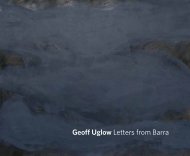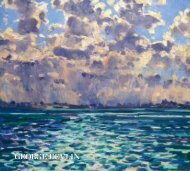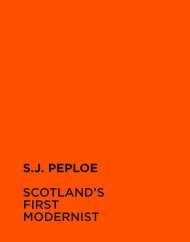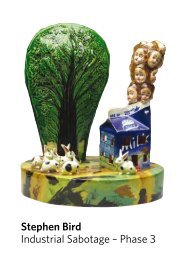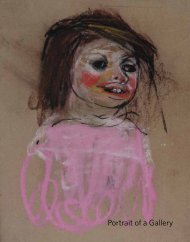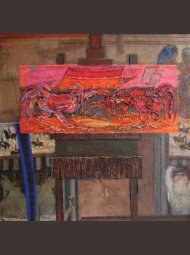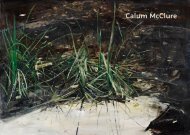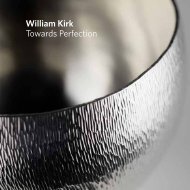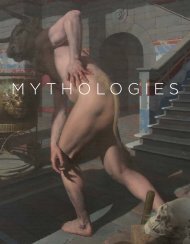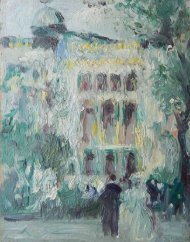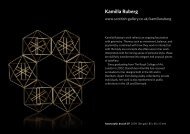Download a PDF of the exhibition catalogue - The Scottish Gallery
Download a PDF of the exhibition catalogue - The Scottish Gallery
Download a PDF of the exhibition catalogue - The Scottish Gallery
Create successful ePaper yourself
Turn your PDF publications into a flip-book with our unique Google optimized e-Paper software.
Alexander was born in Edinburgh, son <strong>of</strong> <strong>the</strong> painter Robert Alexander (1840–1923) from whom he learned much.<br />
He visited Tangier with his fa<strong>the</strong>r and Joseph Crawhall, nine years his senior, in <strong>the</strong> winter <strong>of</strong> 1887–88 which sparked<br />
a lifelong fascination for <strong>the</strong> desert and <strong>the</strong> Arab world. He did study in Edinburgh and Paris with his friend Robert<br />
Burns (1861–1941) but was drawn back to North Africa and was based in Egypt, living on a houseboat on <strong>the</strong> Nile<br />
from 1892–1896. James Caw writing in his book <strong>Scottish</strong> Painting Past and Present (TC and EC Jack, Edinburgh, 1908)<br />
notes ‘… that this young painter dwelt among <strong>the</strong> Arabs, living <strong>the</strong>ir simple life in <strong>the</strong> tents and sharing <strong>the</strong>ir daily lives.’<br />
His depictions <strong>of</strong> camels and donkeys and <strong>the</strong> s<strong>of</strong>t, varied, fawn coloured landscape with warm sunlight and purple<br />
shadow are observed as an intimate not a tourist.<br />
Caw ascribes a similar charm to Alexander’s home landscape. ‘Low-horizoned ploughed lands with birds on<br />
wing on <strong>the</strong> high airy sky; long ebb-tide sands glimmering in <strong>the</strong> deepening twilight; and bare uplands with nibbling<br />
sheep seen in <strong>the</strong> delicate harmony wrought by a grey spring day – <strong>the</strong>se and such-like are <strong>the</strong> <strong>the</strong>mes he loves.<br />
It is as a painter <strong>of</strong> birds and <strong>the</strong> natural world for which he is rightly celebrated. <strong>The</strong> Fine art Society mounted an<br />
<strong>exhibition</strong> for <strong>The</strong> Edinburgh Festival in 1985 called Camels, Cobwebs and Honeysuckles featuring Alexander and Crawhall<br />
and <strong>the</strong>y stand out as two <strong>of</strong> <strong>the</strong> most brilliant draftsmen <strong>of</strong> <strong>the</strong>ir generation whose particular, quiet vision has <strong>of</strong>ten<br />
been drowned out – by noisier more self-conscious art. Caw was hugely tempted to include Crawhall in his history but<br />
as a strict nationalist <strong>the</strong> painter’s Northumbrian origin ruled him out. Alexander he praises for his delicacy <strong>of</strong> drawing,<br />
his colour: ‘fastidious and harmonious’ and his rare regard for decorative placing. His love <strong>of</strong> birds is clear in so many<br />
delicate, perfect representations <strong>of</strong> birds and he kept owls and peacocks at his home in Musselburgh.<br />
Alexander had <strong>the</strong> first <strong>of</strong> four one-man shows with <strong>The</strong> <strong>Scottish</strong> <strong>Gallery</strong> in 1901 and <strong>the</strong> following year was<br />
made an associate <strong>of</strong> <strong>The</strong> RSA. In 1904 he married into <strong>the</strong> Dott family and settled in Edinburgh. Sadly he had a stroke<br />
in 1917 and died aged only fifty-six. His memorial <strong>exhibition</strong> was held at <strong>The</strong> <strong>Gallery</strong>.<br />
46



